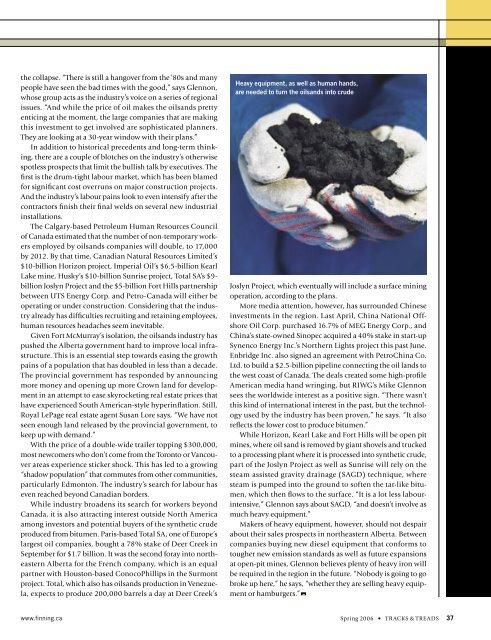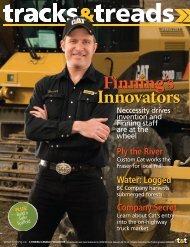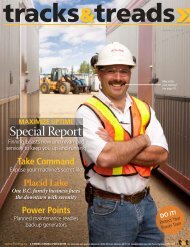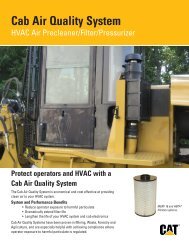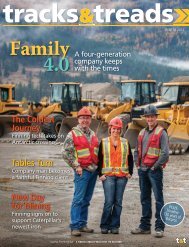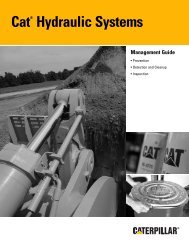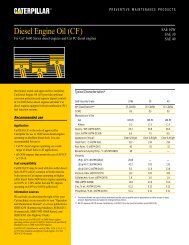Wanted Tour - Finning Canada
Wanted Tour - Finning Canada
Wanted Tour - Finning Canada
Create successful ePaper yourself
Turn your PDF publications into a flip-book with our unique Google optimized e-Paper software.
the collapse. “There is still a hangover from the ’80s and manypeople have seen the bad times with the good,” says Glennon,whose group acts as the industry’s voice on a series of regionalissues. “And while the price of oil makes the oilsands prettyenticing at the moment, the large companies that are makingthis investment to get involved are sophisticated planners.They are looking at a 30-year window with their plans.”In addition to historical precedents and long-term thinking,there are a couple of blotches on the industry’s otherwisespotless prospects that limit the bullish talk by executives. Thefirst is the drum-tight labour market, which has been blamedfor significant cost overruns on major construction projects.And the industry’s labour pains look to even intensify after thecontractors finish their final welds on several new industrialinstallations.The Calgary-based Petroleum Human Resources Councilof <strong>Canada</strong> estimated that the number of non-temporary workersemployed by oilsands companies will double, to 17,000by 2012. By that time, Canadian Natural Resources Limited’s$10-billion Horizon project, Imperial Oil’s $6.5-billion KearlLake mine, Husky’s $10-billion Sunrise project, Total SA’s $9-billion Joslyn Project and the $5-billion Fort Hills partnershipbetween UTS Energy Corp. and Petro-<strong>Canada</strong> will either beoperating or under construction. Considering that the industryalready has difficulties recruiting and retaining employees,human resources headaches seem inevitable.Given Fort McMurray’s isolation, the oilsands industry haspushed the Alberta government hard to improve local infrastructure.This is an essential step towards easing the growthpains of a population that has doubled in less than a decade.The provincial government has responded by announcingmore money and opening up more Crown land for developmentin an attempt to ease skyrocketing real estate prices thathave experienced South American-style hyperinflation. Still,Royal LePage real estate agent Susan Lore says, “We have notseen enough land released by the provincial government, tokeep up with demand.”With the price of a double-wide trailer topping $300,000,most newcomers who don’t come from the Toronto or Vancouverareas experience sticker shock. This has led to a growing“shadow population” that commutes from other communities,particularly Edmonton. The industry’s search for labour haseven reached beyond Canadian borders.While industry broadens its search for workers beyond<strong>Canada</strong>, it is also attracting interest outside North Americaamong investors and potential buyers of the synthetic crudeproduced from bitumen. Paris-based Total SA, one of Europe’slargest oil companies, bought a 78% stake of Deer Creek inSeptember for $1.7 billion. It was the second foray into northeasternAlberta for the French company, which is an equalpartner with Houston-based ConocoPhillips in the Surmontproject. Total, which also has oilsands production in Venezuela,expects to produce 200,000 barrels a day at Deer Creek’sHeavy equipment, as well as human hands,are needed to turn the oilsands into crudeJoslyn Project, which eventually will include a surface miningoperation, according to the plans.More media attention, however, has surrounded Chineseinvestments in the region. Last April, China National OffshoreOil Corp. purchased 16.7% of MEG Energy Corp., andChina’s state-owned Sinopec acquired a 40% stake in start-upSynenco Energy Inc.’s Northern Lights project this past June.Enbridge Inc. also signed an agreement with PetroChina Co.Ltd. to build a $2.5-billion pipeline connecting the oil lands tothe west coast of <strong>Canada</strong>. The deals created some high-profileAmerican media hand wringing, but RIWG’s Mike Glennonsees the worldwide interest as a positive sign. “There wasn’tthis kind of international interest in the past, but the technologyused by the industry has been proven,” he says. “It alsoreflects the lower cost to produce bitumen.”While Horizon, Kearl Lake and Fort Hills will be open pitmines, where oil sand is removed by giant shovels and truckedto a processing plant where it is processed into synthetic crude,part of the Joslyn Project as well as Sunrise will rely on thesteam assisted gravity drainage (SAGD) technique, wheresteam is pumped into the ground to soften the tar-like bitumen,which then flows to the surface. “It is a lot less labourintensive,”Glennon says about SAGD, “and doesn’t involve asmuch heavy equipment.”Makers of heavy equipment, however, should not despairabout their sales prospects in northeastern Alberta. Betweencompanies buying new diesel equipment that conforms totougher new emission standards as well as future expansionsat open-pit mines, Glennon believes plenty of heavy iron willbe required in the region in the future. “Nobody is going to gobroke up here,” he says, “whether they are selling heavy equipmentor hamburgers.”www.finning.ca Spring 2006 • TRACKS & TREADS 37


